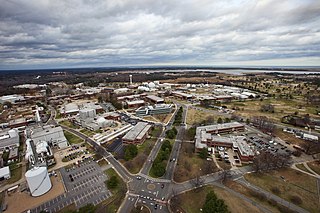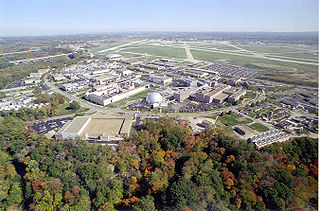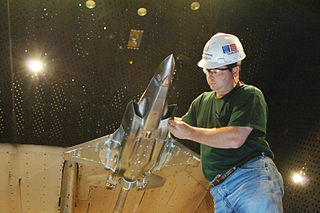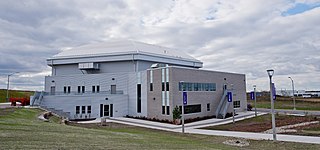
Wind tunnels are machines where an object is held stationary inside a tube, and air is blown around it to study the interaction between the object and the moving air. They are used to test the aerodynamic effects of aircraft, rockets, cars, and buildings. Different wind tunnels range in size from less than a foot across, to over 100 feet (30 m), and can have air that moves at speeds from a light breeze to hypersonic velocities.

The Ames Research Center (ARC), also known as NASA Ames, is a major NASA research center at Moffett Federal Airfield in California's Silicon Valley. It was founded in 1939 as the second National Advisory Committee for Aeronautics (NACA) laboratory. That agency was dissolved and its assets and personnel transferred to the newly created National Aeronautics and Space Administration (NASA) on October 1, 1958. NASA Ames is named in honor of Joseph Sweetman Ames, a physicist and one of the founding members of NACA. At last estimate NASA Ames had over US$3 billion in capital equipment, 2,300 research personnel and a US$860 million annual budget.

The Langley Research Center, located in Hampton, Virginia near the Chesapeake Bay front of Langley Air Force Base, is the oldest of NASA's field centers. LaRC has focused primarily on aeronautical research but has also tested space hardware such as the Apollo Lunar Module. In addition, many of the earliest high-profile space missions were planned and designed on-site. Langley was also considered a potential site for NASA's Manned Spacecraft Center prior to the eventual selection of Houston, Texas.

NASA John H. Glenn Research Center at Lewis Field is a NASA center within the cities of Brook Park and Cleveland between Cleveland Hopkins International Airport and the Rocky River Reservation of Cleveland Metroparks, with a subsidiary facility in Sandusky, Ohio. Its director is James A. Kenyon. Glenn Research Center is one of ten major NASA facilities, whose primary mission is to develop science and technology for use in aeronautics and space. As of May 2012, it employed about 1,650 civil servants and 1,850 support contractors on or near its site.

The Bell Aerosystems Lunar Landing Research Vehicle was a Project Apollo era program to build a simulator for the Moon landings. The LLRVs were used by the FRC, now known as the NASA Armstrong Flight Research Center, at Edwards Air Force Base, California, to study and analyze piloting techniques needed to fly and land the Apollo Lunar Module in the Moon's low gravity environment.

The Arnold Engineering Development Complex (AEDC), Arnold Engineering Development Center before July 2012, is an Air Force Materiel Command facility under the control of the Air Force Test Center (AFTC). Named for General Henry "Hap" Arnold, the father of the U.S. Air Force, AEDC is the most advanced and largest complex of flight simulation test facilities in the world.

The National Wind Institute (NWI) at Texas Tech University (TTU) was established in December 2012, and is intended to serve as Texas Tech University's intellectual hub for interdisciplinary and transdisciplinary research, commercialization and education related to wind science, wind energy, wind engineering and wind hazard mitigation and serves faculty affiliates, students, and external partners.

The Bell Boeing Quad TiltRotor (QTR) is a proposed four-rotor derivative of the Bell Boeing V-22 Osprey developed jointly by Bell Helicopter and Boeing. The concept is a contender in the U.S. Army's Joint Heavy Lift program. It would have a cargo capacity roughly equivalent to the C-130 Hercules, cruise at 250 knots, and land at unimproved sites vertically like a helicopter.

The EFW N-20 Aiguillon was Switzerland's first indigenous jet fighter project. The Swiss Federal Aircraft Factory developed a design for a four-engined swept winged fighter following the end of the Second World War. An unpowered sub-scale N-20.01 glider and a turbojet powered test aircraft, also sub-scale and known as the N-20.02 Arbalète ("Crossbow"), were test flown. A fighter prototype N-20.10 Aiguillon was built but never flown, and a twin-engines N.20.20 Harpon was also proposed but not followed up.

The Full-Scale Tunnel was a wind tunnel at NASA's Langley Research Center. It was a National Historic Landmark.

The Variable Density Tunnel (VDT) was the second wind tunnel at the National Advisory Committee for Aeronautics (NACA) Langley Research Center. Proposed by German aerospace engineer, Max Munk in May, 1921, it was the world's first variable density wind tunnel and allowed for more accurate testing of small-scale models than could be obtained with atmospheric wind tunnels. It was actively used as a wind tunnel from 1923 until its retirement in the 1940s. Langley Research Center historian, James R. Hansen, wrote that the VDT provided results superior to the atmospheric wind tunnels used at the time and was responsible for making NACA, the precursor to NASA, "a world leader in aerodynamic research". It is now on display on the Langley grounds, near the old Reid Conference Center and is a National Historic Landmark.
The Windshear Full Scale Rolling Road Wind Tunnel is an automotive wind tunnel in Concord, North Carolina.
The Bristol Type 92, sometimes known as the Laboratory biplane, was an aircraft built by the Bristol Aeroplane Company to address the differences between wind tunnel cowling models and full scale cowling for radial engines and was designed as a scaled-up version of a wind tunnel model aircraft. One was built and flew in the mid-1920s.
The Aeronautical/Astronautical Research Laboratory (AARL) is an aerospace engineering research facility operated by Ohio State University. It is the principal research facility of the College of Engineering's Department of Aerospace and Astronautical Engineering. It is located on the grounds of Ohio State University Airport, in Columbus, Ohio.

The Wind Engineering, Energy and Environment (WindEEE) Dome is a hexagonal-shaped vertical wind tunnel proposed for the University of Western Ontario. It is designed to simulate localized, high-intensity wind patterns such as downbursts and tornadoes that have never been studied before.

The HSTDV is an unmanned scramjet demonstration aircraft for hypersonic speed flight. It is being developed as a carrier vehicle for hypersonic and long-range cruise missiles, and will have multiple civilian applications including the launching of small satellites at low cost. The HSTDV program is being run by the Defence Research and Development Organisation (DRDO).
The Virginia Tech Stability Wind Tunnel is a medium-scale wind tunnel located at Virginia Polytechnic Institute and State University in Blacksburg, Virginia. With a test section measuring 6 by 6 ft and maximum wind speeds of approximately 262.6 ft/s (80.0 m/s), it is one of the largest university-owned wind tunnels in the United States, and is used for a wide variety of research projects within the college as well as being contracted out for commercial use, especially product testing. Professor William Devenport is the current director, and Dr. Aurelien Borgoltz is the assistant director.
The Deutsche Luftfahrtforschungsanstalt was a secret German facility for airframe, aeroengine, and aircraft weapons testing during the Second World War. It was Germany's "most advanced and extensive [aviation] research establishment, outside of the existing Erprobungsstelle network of military aviation evaluation facilities, themselves headquartered at Rechlin.

The Lockheed Martin X-59 Quesst, sometimes styled QueSST, is an American experimental supersonic aircraft being developed at Skunk Works for NASA's Low-Boom Flight Demonstrator project. Preliminary design started in February 2016, with the X-59 to be delivered to NASA in 2021 for flight testing in 2023. It is expected to cruise at Mach 1.42 at an altitude of 55,000 ft (16,800 m), creating a low 75 Perceived Level decibel (PLdB) thump to evaluate supersonic transport acceptability.

The Propeller Research Tunnel (PRT) was the first full-scale wind tunnel at the National Advisory Committee for Aeronautics (NACA) Langley Research Center, and the third at the facility. It was in use between 1927 and 1950 and was instrumental in the drag reduction research of early American aeronautics. In 1929, NACA was awarded its first Collier Trophy for the NACA cowling which was tested and developed using the Propeller Research Tunnel.
















